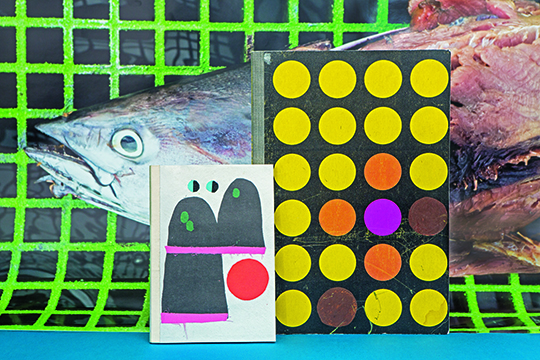TWO ARTISTS’ BOOKS: COLLAGE & MAN OVERBOARD
| March 26, 2015 | Post In LEAP 31
Translated / Xiaowei Wang

UNLIKE THE WRITTEN word, where the battlefield lies between ink and paper, artists’ books serve as a delayed convergence of work and viewer. These works of art do not sit inside the white cube waiting for visitors, but instead seek their audiences in a wide marketplace. Yan Cong’s Collage, which was published for an exhibition at Beijing’s Star Gallery, has posted feedback on Taobao with a satisfaction rating of 100%. The only criticism that appears relates to the quality of paper and book size.
Those visiting a gallery might criticize the lighting or arrangement of works for how they affect perception, but they rarely criticize the gallery walls for being painted too roughly. In a book, however, the artwork becomes intrinsically tied to the material of the book itself: the quality of paper, the printing, and the cover all become part of the artwork. This transforms the artists’ book into a commodity, subject to new points of critique from viewers.
Tal R and Yan Cong are both highly trained artists; their work may appear naive in this sense, tapping into subcultures and cartoons, but this naiveté belies the fact that both artists have highly mature work with a strong conceptual practice and control over their medium.
In Collage, Yan Cong deploys fabric and paper alongside recurring images of snowmen, cats, and mirrors. Portraits of people in profile face right. The most frequently occurring figure is a man, sometimes naked and sometimes wearing red shorts. He paints, he eats watermelon, he plays with a kitten; this man may be the artist himself. In one image, the man in red shorts sits weeping in front of the mirror, a white, female hand resting on his shoulder. The heartbreaking scene seems to come from the private life of another.
Yet, the way Yan Cong renders emotion is compelling in its plainness. Without exaggerating heartbreak, he gives few other details, only enough visual clues to leave the audience to wonder about the source of the tears. These tears, so similar to the shape of the figure’s nose, remain ambiguous in silhouette.
In the handmade aesthetic of this catalogue, people and animals are cute and lovable, and the fabric of the collages brims with a warm, cloth texture that brings a sense of maternal comfort. The calmness and sobriety of the everyday reflects the maturity of a grown man—someone who can hardly be called naive.
Tal R’s catalogue Man Overboard, from an exhibition in Dusseldorf, is similar to Yan Cong’s, but he does not use comics as his form; instead, his work delves into visual atmosphere. His exhibition “Man Overboard” is an explosive personal cosmos with paintings, collage, sculpture, and fashion design. In the exhibition, colors and shapes are piled high in a total experience, making it difficult to focus on any particular piece in the show.
What does a catalogue for such a dense show look like? If Yan Cong takes parts of his life and manages to eloquently put them into a book, could Man Overboard be read as more than the narrative of an exhibition? Indeed, in the collage section of Yan’s book, parts of the page are left blank, suggesting that the artist reacts to his medium, using the same loose, natural language in response to his own work within the book.
Returning to the online buyer feedback on Collage, the paper used for the cover is actually thinner than that used inside. In fact, the thickest part of the book is the spine; since the cover is much thinner, the cover is left slightly bent after paging through it. With the cover no longer serving the function of protecting the book’s interior pages, it will certainly look older and used faster than any other book on the shelf.
Tai R’s book is the opposite—a wealth of information on thick paper with a heavy cover. Inside, he collects personal moments, images of his studio, individual works, exhibition views, and collages. He turns the volume into a personal scrapbook, leaving space for reader discoveries on the last page, where small letters appear: “my home is the sea but not for me.”
Yan Cong, Star Gallery, 2014, 170pp., Chinese and English
Tal R, Walther König, Köln, 2012, 104pp., English and German


